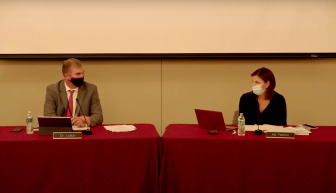The superintendent of schools said Tuesday that New Canaan will continue following state public health guidance as winter sports such as basketball and ice hockey near, and only small-group conditioning and non-contact drills are recommended indoors.
The Connecticut Department of Public Health has said that “high-risk sports” that also include wrestling, lacrosse, competitive cheer and dance should not be played beyond those activities, Dr. Bryan Luizzi said during a special meeting of the Board of Education.

Superintendent of Schools Dr. Bryan Luizzi and Board of Education Chair Katrina Parkhill at the Oct. 6, 2020 special meeting, held in the Wagner Room at New Canaan High School. NCPS YouTube channel
“It also recommends that indoor moderate-risk sports should only be played if they could be considered low-risk with mitigation strategies,” Luizzi said during the meeting, held in the Wagner Room at New Canaan High School and viewable on the district’s YouTube channel. An example of such a strategy is volleyball, where the wearing of masks moves it from high- to moderate-risk, under DPH findings.
“Indoor moderate risk sports such as basketball and hockey that don’t have similar mitigation strategies available, like the masks, are in that case DPH recommends only small-group conditioning and non-contact indoors,” he said.
Luizzi added, “Beyond that, they recommend that you do it outdoors because they don’t believe there is a mitigation strategy that would make the difference. Same with basketball.”
The comments can during an update on COVID-19 as the district reopens the public schools for full in-person learning in phases. At the time of the meeting, grades K-6 of New Canaan Public Schools were already open, and 249 students in grades K-12 had opted for full-time e-learning, about 6%, Luizzi said. He said that on Tuesday the district learned of a Saxe Middle School student who had tested positive for the virus. As of Wednesday afternoon, the district’s continuously updated online operations guide, “Charting Our Course,” said that in addition to that student, one staff member each at NCHS and West School were isolating as the result of a positive test, while 25 students and 17 staffers district-wide were in quarantine as a result of “close contact” (within six feet for 15 minutes or more) with a positive case.
Those numbers are low and both kids and teachers are “very happy” to be back in school, as are many parents, Luizzi said.
“Our success in all of this process is really what’s enabling us to keep our schools open,” he said, adding, “ The DPH continues to report few, if any, cases of spread in the schools and that has to do with mitigation strategies in place—all of what we are doing and how we are quickly responding. We are seeing it ourselves, the cases that we are talking about come from outside into the schools. But we are not seeing incidents of spread within the schools at this point, which is good.”
When a positive case does surface, district officials work with others—such as New Canaan Health Director Jenn Eielson and the district’s nursing supervisor, Janet Reed—to review schedules and seating charts, among other tools, and determine who should be quarantined for reasons of close contact. Luizzi commended them, as well as teacher union leaders, for their diligence and problem-solving approaches that have helped keep the school buildings open.
Regarding the sports, he said, “These are the recommendations from the DPH, and how they get translated and applied has really been local decisions. And I continue to work with Jenn and the first selectman and the selectman’s offie and [Dr.] Harrison Pierce, our district doctor, and Dr. Reed and others to kind of interpret and try and make the best decision one way or another. Now, as the superintendent of the Board of Ed, in public schools, if these are the recommendations of the Department of Public Health it is my recommendation that we follow them as a Board of Education and for the reasons we talked about last week.”
The district’s director of finance and operations, Dr. Jo-Ann Keating, reported that the closure of public school buildings March 12 led to a savings of about $2.1 million last academic year. For the 2020-21 school year, some $2.5 million in additional COVID-related expenses are projected.
“Everything we did we did for a reason and we thought it out very clearly before we spent money,” Keating said.

Board of Education member Bob Naughton at the Oct. 6, 2020 special meeting, held in the Wagner Room at New Canaan High School. NCPS YouTube channel
Paid and encumbered costs to date come to $1,943,091, she said—including $151,869 for personal protective equipment, $508,559 for technology, $316,087 for instructional supplies, $132,546 for cleaning supplies, $308,303 for additional custodial staff, $22,581 for transportation (mid-day runs for kindergarteners) and $472,283 for permanent special and regular ed subs.
Luizzi and all but two Board of Education members wore masks during the meeting. Dionna Carlson and Bob Naughton were seated at a far end of the dais, each behind a kind of three-sided plastic shield. Board members appeared to be seated six feet apart.
Can it be explained why my kindergartner and 2nd grader need to wear a mask on the bus and in school buildings, but it appears members of the BOE do not need to do this when they are inside school buildings. The exceptions listed in ‘Charting our course’ are pretty tight, and mortality data from Covid would appear to indicate higher age (than school age) has a large impact on very negative outcomes. If these members of the BOE are medically at high risk it might make sense for them to zoom into the meeting rather than come in person. Is this pretty common that adults in our school buildings are not wearing masks – yet we require kids to? What gives – did I miss something?